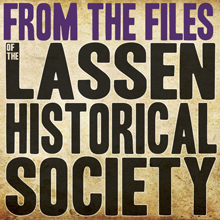

The town of Constantia has come and gone, but considerable memories remain of the ‘good old days’ when the striking Ross mansion, called the ‘White House’, stood above the little community in Long Valley.
Albert Ross’ efforts began in 1863, when he purchased the property from his brother, William. The ranch sat along the old stage route, and as the N-C-O railroad pushed through the valley in the late 1880’s, it put Albert Ross’ ranch in an enviable position.
The Ross brothers, including William Laws Ross, Robert Emory Ross, and Albert Elijah Ross, continued a business partnership in Long Valley for many years.
In May, 1874, a fire consumed the home which the Albert Ross family had lived in since their arrival in the valley, and in September, 1874, construction of the 17-room, $14,000 mansion began.
The Ross family had high hopes for the area. Beef and dairy cattle roamed the valley. The water system, which brought clean clear water through a pipe from the mountain above, was well-known for its consistency, and provided enough power to operate a grindstone. There were extensive orchards and gardens. It was a beautiful, thriving place.
But in December, 1881, the family suffered a great loss with the death of their 6-year-old daughter, Rose. She was buried on the hill behind the mansion. Also in 1881, William Ross died, and in 1883, Robert Ross was seriously injured in a fall from a horse. By the late 1880’s, the Albert Ross family had essentially moved to San Jose where the children were to attend school, and in 1898, the Long
Valley property was sold to wealthy railroad owner and South African mine owner, Henry Butters.
It was Butters who blessed the ranch with the name of ‘Constantia’, after a lush wine-growing region in South Africa. Butters added considerably to Constantia, building a chapel, carriage house, and additions to the mansion itself. He improved the ranch and purchased additional property to add to the acreage. The ranch became a small town, mostly owned by Butters, which included a store, Wells Fargo and telegraph offices, and dwellings.
But by 1904, Butters sold the mansion and 500 acres to Earnest Jordan, who had the property for only two years before selling to J. C. Cooley, who promptly sold to Nevada Senator, Patrick Flanigan. Flanigan, an Irish sheepherder, had amassed quite a bit of money, and bought several ranches in Nevada and California. Butters then sold his remaining property to Flannigan.
Flannigan was partners with U.M. Slater in the Reno Meat Company (later Pyramid Land & Livestock Co.), and they planned to grow hay on the property to feed the beef and mutton destined for their slaughterhouse. They also had a large herd of cattle on the range.
The mansion and a small piece of meadow was to be retained by Butters for use as a ‘summer house’. The N-C-O planned to put up corrals and make their headquarters at Constantia. All-in-all, the place was bustling.
But Flanigan’s quest to promote his political goals took a toll on his finances. After borrowing a substantial sum to fund his reelection to the Nevada Senate, he didn’t win. He lost most of his property, except for his Nevada home which he had put into his wife’s name.
He did retain the Constantia ranch, spending vacations there with his family until 1913. During the years that Flanigan was attempting to reinvent his fortune, he may have rented the White House.
There are instances where others, including George Wingfield, who told of taking a trip in 1912 to his “shooting lodge” at Constantia, noted using the mansion.
Flanigan died in 1920, and the Constantia property was purchased by William Galeppi in 1924 from the Pyramid Land & Livestock Company. The Galeppi’s had owned property in Long Valley since 1904, and Mrs. Galeppi lived there until her death in 1943. They reportedly never lived in the mansion itself, but the Galeppi family has remained in the area.
Through the years since the Flanigans left the mansion, it sat mostly unused with its furnishings still inside, and in 1964 vandals lit a fire and destroyed it. Today, little is left of the beautiful home site, but the monument to little Rose Ross still remains guarding her grave.





